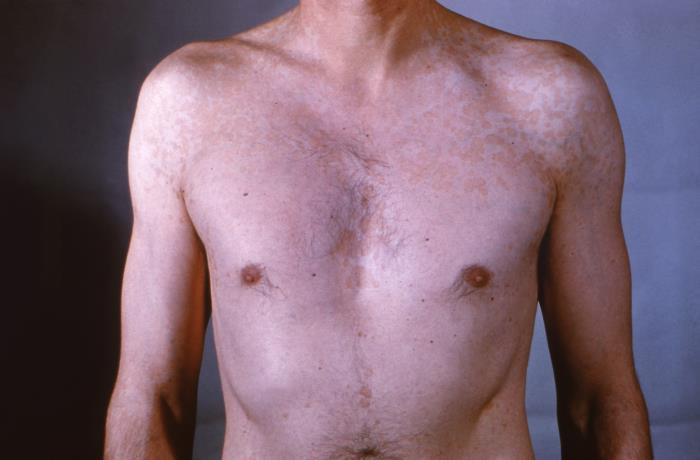Playlist
Show Playlist
Hide Playlist
Pityriasis (Tinea) Versicolor Infection on Darker Skin: Epidemiology and Etiology
-
Slides Pityriasis Tinea Versicolor Infection on Darker Skin Epidemiology and Etiology.pdf
-
Download Lecture Overview
00:01 Welcome to our lecture on Pityriasis versicolor or tinea versicolor. 00:07 This is a common superficial fungal infection caused by the yeasts of genus Malassezia. 00:14 It's also known as tinea versicolor. 00:16 As mentioned, do note that this condition is not contiguous and it is not a reflection of poor hygiene. It occurs worldwide and it's more common in hot and humid regions. 00:34 It most commonly affects adolescents and young adults. 00:41 So what causes tinea versicolor? There's about 14 different species within the Malassezia genus, but the most common causes are globosa, sympodialis and Malassezia furfur. 00:56 Let's focus on pathophysiology. 01:00 Malassezia is a normal constituent of human skin flora. 01:04 It is dependent on lipids for survival. 01:09 And that's why it's commonly found in seborrheic regions of the skin. 01:14 Different factors such as genetic predisposition, warm and humid environments, immunosuppression, malnutrition can cause the transformation of yeast cells from saprophytic to parasitic mycelial forms. So that summarizes the pathogenesis of tinea versicolor. 01:36 Clinically, tinea versicolor can present with hyper or hypopigmented lesions. 01:44 And in fact, the term versicolor refers to the variable changes in cutaneous pigmentation that can occur. 01:52 The fungus produces azelaic acid, which inhibits tyrosinase and gives you the hypopigmented patches in those who present with hypopigmented lesions. 02:06 Some of the predilection sites in adults are the upper trunk, the proximal upper extremities, back, and the rare facial involvement. 02:19 In children one may get involvement of the face, which is a common presentation. 02:26 So clinically, tinea versicolor presents with scaly hypopigmented, macules or patches. One m ay also get hypopigmented, macules or patches. And sometimes when you stretch the skin, the lesions become more conspicuous, or if you scrape them with a wooden spatula, you can actually accentuate the appearance of the lesions. 02:52 This is a patient again presenting with scaly papules on the face. 02:57 And you can see that these look hypopigmented. 03:00 So this is a hypopigmented variant. 03:04 One can also get these macules and patches coalescing together, forming patches and plugs, and become quite extensive. 03:13 And in this patient, the lesions are hyperpigmented if you compare with a normal skin color on the anterior chest. 03:22 One can also get a condition called pittosporum folliculitis, where one sees lesions that look like acne. 03:29 They're monomorphic and you tend to see it on the trunk. 03:32 And that's due to pityrosporum folliculitis. 03:38 The diagnosis of tinea versicolor can be made using Wood's lamp, where one sees yellow-green fluorescence of the affected areas. 03:46 One can also use dermoscopy and skin scraping, and you put the scales on the slide and one sees hyphae and yeast cells. 03:56 And sometimes we say this looks like spaghetti and meatballs. 04:01 The spaghetti being the hyphae and the meatballs being the yeasts. 04:09 Fungal culture is usually negative due to the difficulties of in vivo growth. 04:15 Biopsy can also be done, particularly for pityrosporum folliculitis, which may sometimes be difficult to differentiate from acne or other causes of folliculitis. Differential diagnosis in children is seborrheic dermatitis, which usually has thicker scales and other areas of involvement. 04:38 Pityriasis rosea that we spoke about can also have small patches with a Christmas tree-like distribution on the trunk. 04:48 Pityriasis alba is usually asymptomatic and mainly affects children and has facial predilection, so it can also be confused with tinea versicolor and lastly vitiligo, which is usually not scaly, but you do get hyperpigmented lesions. 05:07 The management involves topical therapy, which is a treatment of choice. 05:13 And one can use the following medications topically to treat tinea versicolor. 05:21 Systemic treatment is indicated in cases of extensive clinical presentation. 05:27 Recurrence of the disease or failed topical therapy. 05:31 And the following systemic drugs are used to treat severe extensive tinea versicolor or when there's recurrence. 05:40 Recurrence tends to be common to. 05:43 To those prone to recurrence. 05:45 You may need prophylactic treatment. 05:49 You need to inform patients that post-inflammatory hyperpigmentation occurs more often in dark skin, and the skin color changes typically resolve within 1 to 2 months. So if you're treating patients of skin of color, you need to warn them about this. 06:07 And so that they don't think that the disease is still active.
About the Lecture
The lecture Pityriasis (Tinea) Versicolor Infection on Darker Skin: Epidemiology and Etiology by Ncoza Dlova is from the course Fungal Skin Infections in Patients with Darker Skin.
Included Quiz Questions
Here are three quiz questions in GIFT format covering the learning objectives for pityriasis versicolor: ::Pityriasis Versicolor Etiology::Which genus of fungi is responsible for causing pityriasis versicolor?
- Malassezia
- Trichophyton
- Candida
- Microsporum
- Aspergillus
Which of the following best explains why pityriasis versicolor can present with hypopigmented patches?
- The fungus produces azelaic acid which inhibits tyrosinase
- The fungus destroys melanocytes in the affected areas
- The fungus forms a physical barrier preventing UV penetration
- The fungus produces melanin-degrading enzymes
- The fungus induces apoptosis of keratinocytes
What characteristic microscopic finding is described as "spaghetti and meatballs" in skin scrapings from pityriasis versicolor?
- Hyphae and yeast cells
- Grouped cocci and rod-shaped bacteria
- Granular deposits and nuclear dust
- Melanin fragments and keratinocyte debris
- Lymphocytes and neutrophils
Customer reviews
5,0 of 5 stars
| 5 Stars |
|
5 |
| 4 Stars |
|
0 |
| 3 Stars |
|
0 |
| 2 Stars |
|
0 |
| 1 Star |
|
0 |




